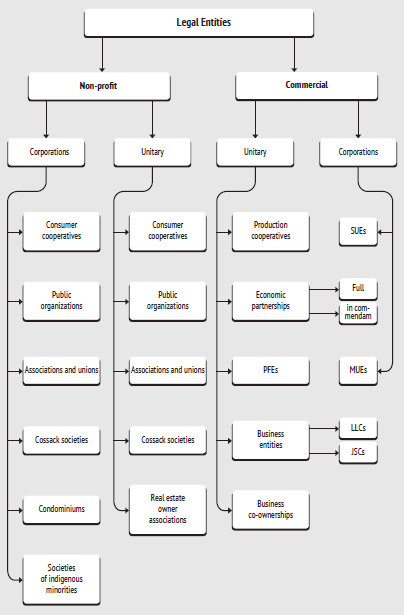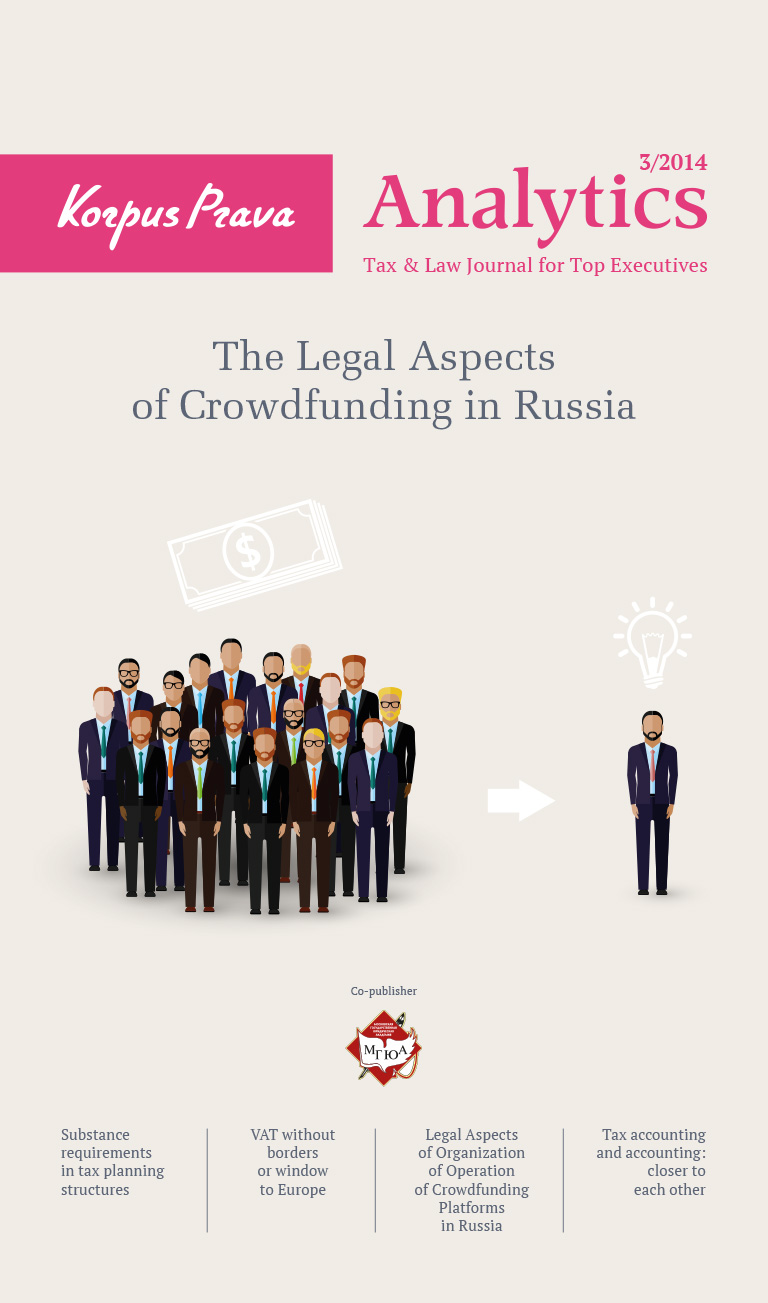- Cyprus Citizenship Scheme for Foreign Investors
- Squeezed But Pleased: Taxation of Passive Income in the European Union
- VAT Without Borders or Window to Europe
- Legal Aspects of Organization of Operation of Crowdfunding Platforms in Russia
- Substance Requirements in Tax Planning Structures
- “Deposit Splitting” of Individuals. Legal Civil and Criminal Aspects
Corporate Law Reform
The past year 2014 is best remembered for its succession of important and significant changes that affected the foundations of the Russian civil law.
The adopted innovations did not come by the part of the civil law, which regulates corporate relations as well. We propose to consider the more important of them.
Organizational and Legal Form of Legal Entities
The new edition of the Civil Code of the RF lays down a different approach to the classification of organizational and legal forms of legal entities. So, all legal entities (such as non-profit and commercial ones) are now divided into corporations and unitary entities.
Corporations are organizations the members of which have the right to participate in them and constitute the supreme governing body. The organizations, whose founders do not become members and do not acquire membership rights, are unitary entities. As for the corporations the law provides for uniform rules of management and rights of members. No similar norms in respect of unitary organizations are provided for.
The list of organizational and legal forms of organizations itself did not change significantly. Nevertheless there are some changes. So, the additional liability company (ALC) and the closed joint stock company (CJSC) are excluded from the possible forms of economic activity. In addition, a new organizational and legal form of a non-profit organization is created – real estate owner association, which means association of real estate owners created for joint possession, use and disposal within the established limits of the jointly owned (used) real estate, as well as for achievement of other purposes.
Schematically, the new classification of legal entities can be represented in the diagram below:

Business Partnerships and Companies
Business partnerships and companies are commercial organizations with authorized (contributed) capital divided into stakes (contributions) of founders (members).
The innovations divided business companies into public and non-public ones. Public companies are joint-stock companies the shares of which are publicly placed or publicly listed as provided for by the law on securities market. The provisions on public companies also apply to joint-stock companies, the articles of association and the corporate name of which contain an indication on the public nature of the company. Non-public companies are limited liability companies and joint stock companies that do not meet the requirements of publicity.
An important innovation is also the provision of the possibility to determine the amount of powers of non-public business company not only in proportion to the stakes in the authorized capital, but also under other rules, if it is provided by the articles of association of the company or the corporate agreement. In this case, information on corporate agreement and on the amount of powers of members of the company provided for by it will be recorded in the USRLE.
Besides, now if members of a company make non-cash contributions to the authorized capital, the value of such contributions shall be determined only by the appraiser. The value of the non-cash contribution determined by members can not be higher than the value estimated by an independent appraiser.
Also the rules of payment of the authorized capital upon establishment of a business entity changed – under the common rule founders of a company are required to pay at least ¾ of its authorized capital prior to the state registration of such company. The remaining part must be paid within the first year of operation of the company. Other rules may be provided by law. In this case, if the law permits registration of a company without prepayment of ¾ of the authorized capital, the company’s members are jointly liable for its obligations arising prior to the full payment of the authorized capital.
Now the Civil Code also contains provisions on the procedure for conclusion of corporate agreements, determining their contents and form. Thus, (all or some) members of the business company may enter into an agreement on exercise of corporate rights, according to which they undertake to exercise these rights as provided for or shall abstain from their implementation. The corporate agreement shall be concluded in writing by drawing up a document to be signed by the parties. The members shall notify the company about conclusion of such agreement (not being required to disclose its contents). If a corporate agreement was signed by all members of the company, its violation may be considered grounds for invalidation of the decisions of the body of the business company by means of suit of a member.
Also now for the general meeting of members of a limited liability company to make a decision, such decision must be notarized (if a different way – including signing of minutes by all members or by some of them; using technical means allowing reliably establish the fact of making decision; another way, which is not contrary to the law) is not provided for by the articles of association or by the decision of the general meeting of members of the company adopted by members of the company unanimously.
Responsibility of Controlling Persons
The persons authorized to act on behalf of a legal entity, as well as the members of the collective management body are obliged to act reasonably and in good faith. Should this obligation be violated, the said persons are obliged to reimburse the company the losses incurred as claimed by the company or its members. Any agreement on the limitation of such liability is void.
Furthermore, another person who has effective power to determine the actions of the legal entity, including the ability to give instructions to the members of the governing bodies, is also liable for losses caused by that legal entity).
Constituent Documents of Legal Entities
Under the common rule, the only constituent document of any organization is its articles of association. However, business companies may also act on the basis of the memorandum of association, which has the same legal force as the articles of association do. Upon registration of legal entities model articles of association, the forms of which are approved by the authorized state body may also be used.
Procedure for Establishment of Legal Entity
The innovations also brought universal rules on making decision to establish a legal entity. Thus, in the event of establishment of a legal entity by two or several founders, the decision to establish shall be made unanimously. The decision in this case shall specify information on the establishment of a legal entity, approval of its articles of association, procedure (amount, terms, methods) of formation of its property, election (appointment) of its bodies.
In making decision to establish a corporate organization (based on membership), such decision shall specify information about the results of the vote of founders on the establishment and on the procedure of joint activity of founders for establishment of a legal entity.
Procedure for Reorganization of Legal Entity
The new rules provide for the possibility to perform a mixed reorganization and simultaneous reorganization of several legal entities.
Mixed reorganization means the possibility to simultaneously combine various forms of reorganization (merger, consolidation, division, separation, transformation). Previously, the possibility of a mixed reorganization was indirectly provided only for joint stock companies; now the law does not stipulate such exception and this rule applies to all legal entities. In addition, it is possible to carry out reorganization involving two or several legal entities, including those created in different organizational and legal forms.
In addition, as a result of the adoption of the new innovations, the regulation of the rights of creditors of the reorganized company significantly changed towards significant improvement of their protection. An important innovation is the introduction of joint liability of the newly established legal entity for the debts of the reorganized entity if the successor can not be determined in case of liability or unfair distribution of assets and liabilities.
It should also be noted that the new law provides for the possibility to invalidate the decision on the reorganization of the legal entity, as well as to declare the reorganization failed. The members of the reorganized entity have the right to seek invalidation of the decision on reorganization and may refer to the court within 3 months from making record in the USRLE on beginning of reorganization.
The invalidation of the decision on reorganization shall not result in liquidation of the newly formed legal entities and is not a basis for challenging transactions made by these legal entities. The only consequence of invalidation of a decision on reorganization is provision to a member of the reorganized entity, voting against such decision, the right to claim damages from the following persons:
- From individuals who contributed in bad faith to making the decision on reorganization;
- From legal entities formed as a result of reorganization, the decision on which is invalidated.
However, if the reorganization is invalidated, absolutely different consequences will occur, and namely:
- The legal entities that existed prior to the reorganization will be recovered and the existence of entities formed as a result of reorganization will cease simultaneously;
- The transactions of the newly formed legal entities with contractors who relied on succession in good faith, remain in force for recovered legal entities, which are joint debtors and joint creditors in such transactions;
- The transfer of rights and obligations is invalidated, except for the cases where such rights and obligations pass to the new legal entity from debtors that relied in good faith on succession on the part of the creditor;
- The members of the previously existing legal entity are its shareholders to the extent to which the stakes were owned by them prior to the reorganization, and upon change of members of the legal entity in the course of such reorganization, or by its end the stakes of members of the previously existing legal entity are returned to them.
It should be noted that the reorganization may be invalidated only by court, and only at the request of the member that voted against or did not participate in the meeting in making this decision. The reorganization may be invalidated in the following cases:
- If the members did not make a decision on reorganization;
- If the papers submitted for the state registration contained deliberately false information.
Procedure for Liquidation of Legal Entity
The new edition of the Civil Code of the RF specifies the grounds of judicial or extra-judicial liquidation of organizations. Thus, legal entities may be liquidated by a court decision in the following cases:
- In the event of invalidation of the state registration of legal entity, including in connection with the assumptions made upon its establishment with gross violations of law, while such violations are not remediable;
- In the case where the legal entity operates without proper authorization (license) or in the absence of mandatory membership in the SRO or certificate of admission to a particular type of work, issued by the SRO as required by law;
- In the case where the legal entity carries out an activity prohibited by law or with other repeated or gross violations of law or other legal acts;
- In the case of regular implementation by the public organization, a charitable, other foundation and religious organization of an activity contrary to the statutory goals of such organizations;
- In the case of impossibility to achieve the goals for which the legal entity was established, including in the event where the implementation of the activity of such legal entity becomes impossible or significantly difficult;
- In other cases provided by law.
A legal entity may be liquidated extra-judicially by the decision of its founders (members) or the body authorized by the articles of association.
Your subscription to our journal will definitely boost the efficiency of your specialists and downsize your expenses for consultants.
The journal is available free of charge in the electronic version.
Free Download

